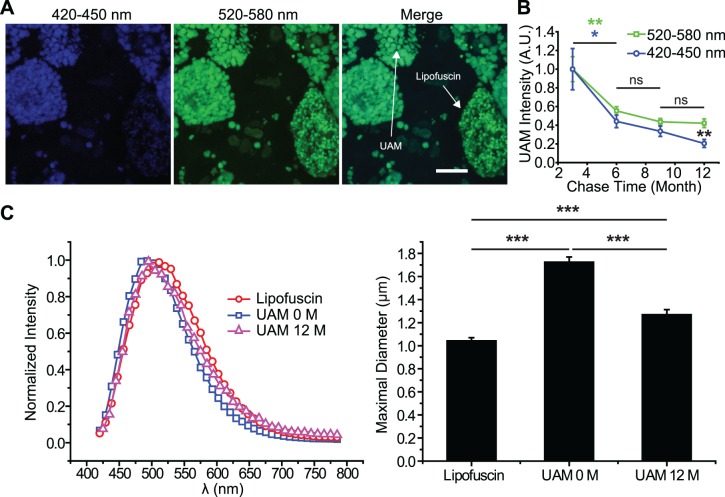Figure 3.
UAM granule spectrum and size evolve over time to more closely mimic in vivo lipofuscin. (A) UAM emission spectrum (405-nm excitation) is blue-shifted compared to carryover lipofuscin granules in ahRPE primary cultures that contain both types of granules. UAM granules are also larger than carryover lipofuscin granules. Images taken within 3 weeks of completing oxOS feedings. Autofluorescence emission simultaneously captured in blue channel (420–450 nm) and green channel (520–580 nm). Scale bar: 10 μm. (B) UAM persists for at least 1 year after last oxOS feeding. Over time, blue UAM autofluorescence (420–450 nm) declines more than the green UAM autofluorescence (520–580 nm), suggesting that UAM spectrum red-shifts when in culture for prolonged periods; 405 nm excitation. n = 10 from hfRPE cultures. Blue and green asterisks signify differences between 3 and 6 months for blue and green autofluorescence, respectively. The blue and green curves are statistically different from each other only at 12 months (double asterisks). (C) UAM emission spectrum (405-nm excitation) is initially blue-shifted compared to carry-over lipofuscin (0 M = 0 months), but this spectrum red-shifts over time to more closely resemble carry-over lipofuscin (12 M = 12 months). Concurrently, UAM granules compact over time, more closely resembling the size of carry-over lipofuscin. n = 50 from hfRPE cultures. *P < 0.05, **P < 0.01, ***P < 0.001.

